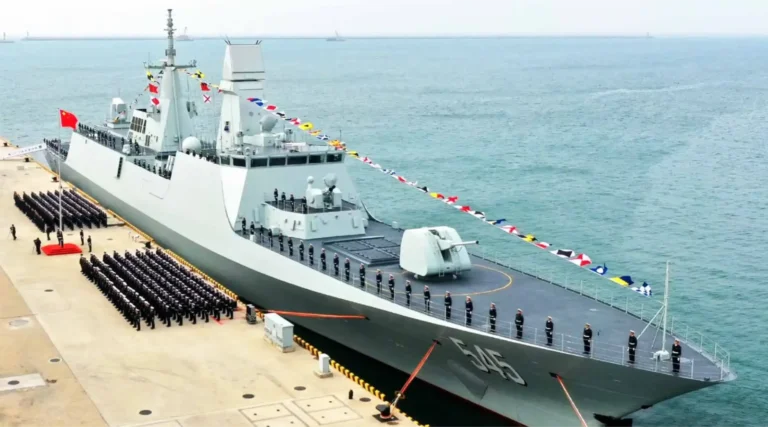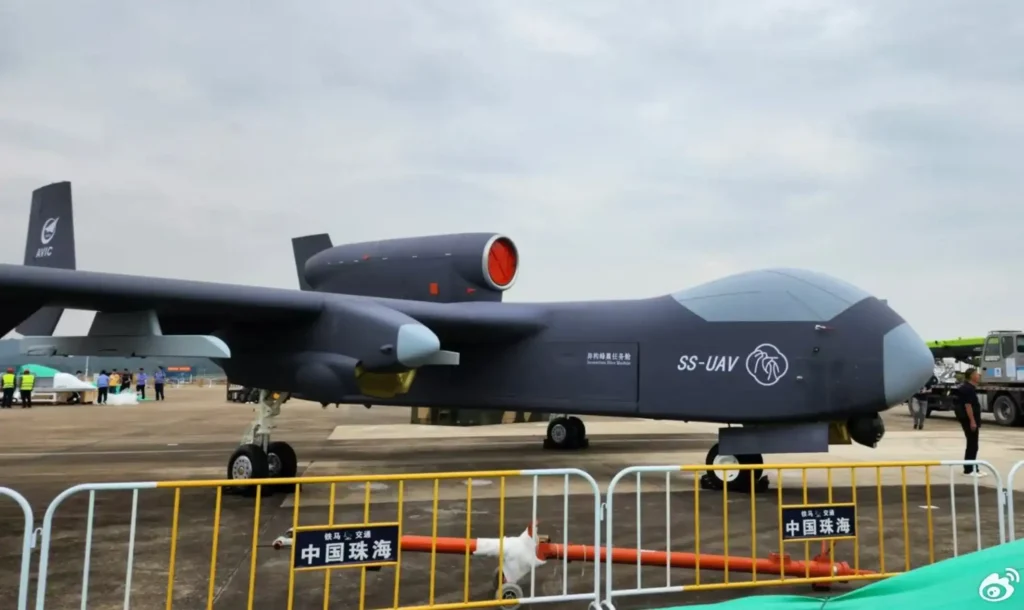Follow Us:

Share
At the recent Zhuhai Airshow, China unveiled a significant leap forward in its military aviation capabilities with the introduction of the SS-UAV, a high-endurance reconnaissance and strike-capable drone.
This advanced unmanned aerial vehicle (UAV) is China’s answer to some of the most formidable UAVs in the world, such as the U.S. RQ-4 Global Hawk and MQ-9 Reaper. With an impressive design and cutting-edge technology, the SS-UAV stands as a testament to China’s growing expertise in UAV development and demonstrates its ambition to establish itself as a major player in global aerial surveillance and tactical operations.

The SS-UAV is designed to offer capabilities that are both expansive and adaptable. Its sleek, aerodynamic frame and long wingspan suggest a focus on endurance, allowing it to cover vast areas for reconnaissance missions over extended periods.
The drone’s sophisticated sensor suite likely includes high-resolution cameras and infrared systems, enabling it to perform detailed surveillance even at high altitudes. This UAV embodies the endurance necessary for prolonged missions, potentially remaining airborne for hours on end without needing refueling or recalibration.
Meanwhile in China: A new, massive UAV (SS-UAV) unveiled at Zhuhai by AVIC. pic.twitter.com/byvXvwNUSO
— Clash Report (@clashreport) November 6, 2024
China’s SS-UAV design suggests a deep focus on versatility as well as endurance. Beyond reconnaissance, the SS-UAV is reportedly capable of carrying out tactical operations, including precision strikes.
This ability to switch seamlessly from surveillance to strike mode makes the SS-UAV a flexible tool for modern warfare. Its adaptability hints at a clear intention to produce a UAV that can not only perform standalone missions but also integrate smoothly into China’s broader military strategy. Such dual capabilities are crucial for effective operation in contested environments, where agility and resilience are paramount.
By examining the strengths of the U.S. RQ-4 Global Hawk and MQ-9 Reaper, it’s apparent that the SS-UAV takes cues from both, aiming to bring together the best of long-endurance surveillance and high-precision strike.
The RQ-4 Global Hawk is renowned for its high-altitude, long-endurance reconnaissance capabilities, making it ideal for sustained observation over large territories. The MQ-9 Reaper, on the other hand, is a highly versatile, strike-capable UAV that has played a key role in numerous missions requiring both surveillance and precision targeting.
China’s decision to incorporate features from these two advanced U.S. drones suggests a determination to meet or exceed the standards set by the Global Hawk and Reaper.
The SS-UAV is not merely a look-alike but a carefully crafted response to the increasing demands of modern aerial warfare, especially in environments where flexibility and survivability are essential. By building on these foundations, China is signaling its intent to compete with — and potentially surpass — American UAV capabilities.
For international observers, the SS-UAV’s introduction at the Zhuhai Airshow represents more than just a technological milestone; it highlights the rapid advancement of China’s UAV sector and signals a growing commitment to enhancing its air force capabilities on a global scale.
The development of the SS-UAV aligns with China’s strategic vision of becoming a dominant force in modern warfare, especially in the realms of surveillance and targeted strike capabilities.
China’s SS-UAV initiative also underscores the importance of unmanned systems in today’s military landscape. High-endurance UAVs like the SS-UAV are invaluable in intelligence-gathering, border monitoring, and maritime patrols.
The ability of these drones to operate in hostile or contested airspaces without risking human lives gives militaries a tactical edge, making them an essential component of modern warfare.
As UAV technology continues to evolve, China’s advancements will undoubtedly influence the global UAV market and the strategies of other nations. The SS-UAV stands as a clear signal that China is ready to join the ranks of advanced UAV-deploying nations and may very well shape future developments in military aviation technology worldwide.
The SS-UAV is likely just the beginning of China’s efforts to enhance its UAV capabilities. With the development of this high-endurance, multi-mission UAV, China has demonstrated both its technological capabilities and its strategic ambitions. As China continues to refine its drone technologies, we can expect further advancements that enhance endurance, precision, and resilience in contested environments.
The SS-UAV’s debut emphasizes China’s commitment to building a modernized, well-equipped air force capable of competing with the world’s leading military powers. For those monitoring global military developments, the SS-UAV is an indicator of China’s growing influence in aerial reconnaissance and tactical operations, and it marks a new chapter in the ever-evolving field of unmanned military aviation.
Share
Defense Feeds is publication focusing on informing, engaging, and empowering the world by providing accurate information from defense technology.
Powered by Defense Feeds © 2025 – All rights reserved.